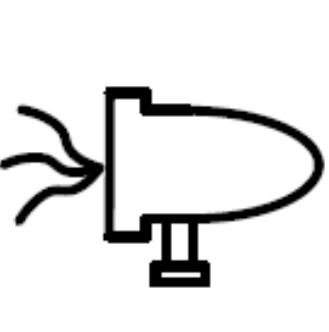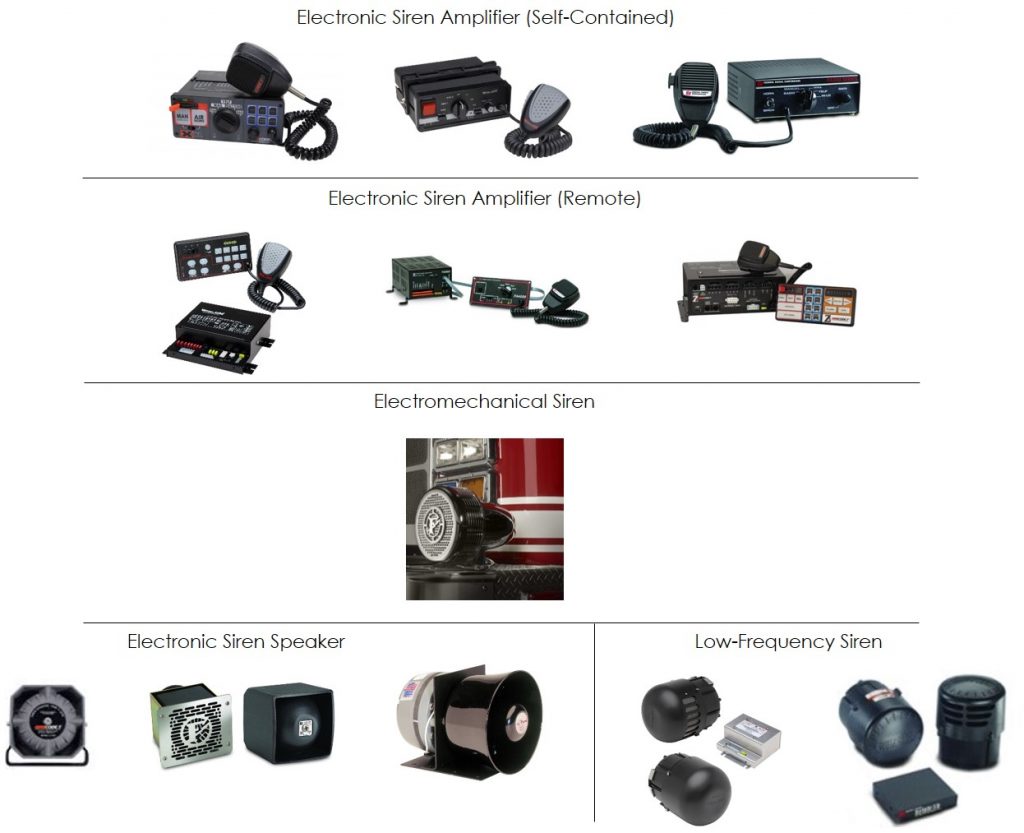Fire Apparatus Sirens
FAMA BUYER’S GUIDE TC050 Fire Apparatus Sirens
Prepared by the FAMA Electrical Subcommittee
This guide does not endorse any manufacturer or product

Contents
Introduction
The end user has many options when it comes to selecting the Siren system for their apparatus. The purpose of this guide is to help the user select a certified system consisting of an amplifier and a speaker.
Overview
The Society of Automotive Engineers (SAE) defines a Siren as, “A device or system for producing acoustical signals that continuously vary in frequency and call for the right-of-way of an emergency vehicle.” SAE defines an Electronic Siren System as a combination of a siren amplifier and speaker(s). It is important to select a Siren System which is SAE J1849 compliant. The National Fire Protection Association (NFPA) complies with all of the Siren standards outlined in this SAE specification. The two siren types recognized are Electronic and Electromechanical. The SAE sets forth requirements, guidelines, and lab test procedures the manufacturer must adhere to. If you reside in California you must adhere to the guidelines of Title 13, Division 2, Chapter 4, Article 8. Sirens are effective devices for calling for the right-of-way by an emergency vehicle. However, they must always be used in conjunction with an effective Visual Warning System, and common-sense defensive driving. CA Title 13 does have higher output requirements and only allows certain tones compared to SAE and NFPA.
Siren System Components
- Electronic Siren Amplifier (Self-Contained) – This is a device which is powered by the apparatus’ electrical system which sends an electronic signal to a speaker. This device is an all in one unit which also includes any operational controls. To be SAE certified, it must include the wail and yelp tones. They will also typically include a simulated air horn tone and possibly other siren tones.
- Electronic Siren Amplifier (Remote) – This is a device which is powered by the apparatus’ electrical system which sends an electronic signal to a speaker. This device is a two-part system consisting of an amplifier and a control head which are mounted in separate locations and connected by a communication line. To be SAE certified, it must include the wail and yelp tones. They will also typically include a simulated air horn tone and possibly other siren tones.
- Electromechanical Siren – Electronic motorized sirens only produce one warning tone (wail) and the level and pitch are varied by the speed of the motor. The speaker and amplifier are all in one.
- Electronic Siren Speaker – This consists of an electro-acoustic transducer (speaker driver) which converts the electrical signal from the amplifier into acoustical energy. The speaker driver is enclosed within a housing to couple and amplify the projected acoustical output.
- Low-Frequency Siren – These are not SAE recognized audio warning devices, however, they have become quite popular. They consist of an amplifier and subwoofer which work in conjunction with the main electronic siren amplifier and produce low-frequency tones in short bursts.

Certification
- Per NFPA 13.9.1.1 the manufacturer of the Siren must provide the OEM building the apparatus a certificate of SAE J1849 compliance.
- Sirens with interchanged components may not meet the SAE J1849 requirements. The purchaser should require the apparatus OEM to provide certification of the Siren System, both the amplifier and speakers tested as a system.
- Only an AEMCA accredited test lab can certify compliance.
- The wail and yelp tones must adhere to the cycling and frequency requirements outlined in SAE J1849 so they can be recognized by the general public when heard.
- CA Title 13 only recognizes: manual wail, wail, and yelp tones. All other third tone options must be disabled. The wail and yelp tones must adhere to the cycling and frequency requirements outlined in CA Title 13, Division 2, Chapter 4, Article 8. The speakers must also produce 120dB on axis to be Title 13 Class A certified.
Speaker Mounting
- Per NFPA 13.9.2, the speaker(s) must be mounted parallel to the ground and as low and far forward on the vehicle as practical. This keeps noise in the passenger compartment to a minimum and prevents possible hearing problems for the occupants.
- The speaker(s) should be mounted parallel to the ground to be most effective.
- The speaker(s) shall not be mounted behind any obstruction.
- Per NFPA 13.9.3, no audible warning equipment shall be mounted on the cab roof.
Control Head Mounting
- The siren controls should be placed within convenient reach of the driver, or the driver and passenger if it is intended for two-person operation.
- In some instances, multiple control switches may be necessary for easy operation from both positions.
- The driver shall be able to manipulate the controls with minimal movement from the normal driving position and without losing eye contact with the road.
Installation
- The manufacturer shall provide a detailed installation guide which describes proper wiring and operation of the siren.
- The manufacturer shall also include warnings against potential hearing loss.
- The manufacturer shall provide all the necessary mounting hardware.
- The guide shall also list the proper fuses or circuit breakers to use, and list the minimum wire gauges necessary for safe operation.
- Current draw should be taken into consideration as well; certain products draw substantially more current than other products.
Other Common Industry Features
- Removable or hard-wired public address microphone.
- Hands-free operation.
- Radio repeat.
- Ability to drive two speakers.
- LED backlighting.
- Silent test speaker diagnostics.
- Input polarity protection.
- Output short circuit protection.
- Microphone override.
- A variety of non-SAE recognized attention grabbing tones are often also included as additional tones.
- Dual-tone siren amplifiers.
- ‘Siren in use’ icon driver for in-vehicle camera systems.
